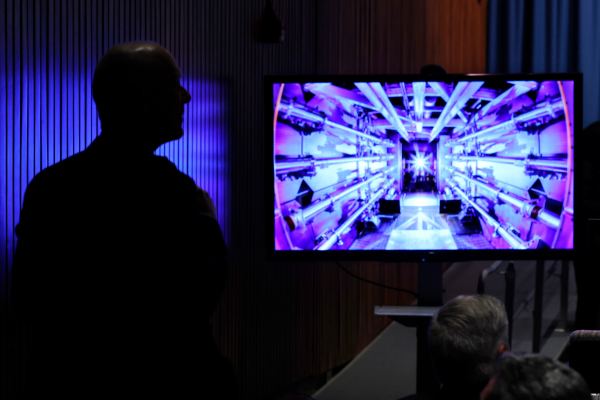It wasn’t a fluke: Researchers at a Department of Energy (DOE) lab have repeated their breakthrough fusion power experiment. Only this time, the results are even better.
On July 30, lasers once again converged on a tiny gold cylinder containing a diamond-coated, deuterium-tritium fuel pellet. When the beams — as many as 192 of them — hit the inside of the cylinder, their energy was turned into X-rays. Those X-rays then bombarded the fuel pellet, forcing it to implode.
Last time, the resulting nuclear fusion reaction released 3.15 megajoules of energy. This time, it produced more than 3.5 megajoules, according to the Financial Times. That reportedly exceeds the amount of energy the lasers imparted on the hohlraum, as the cylinder is called, though it’s unclear by how much.
The lab confirmed the successful repetition of the experiment and said it intends to report the details at either a scientific conference or in a peer-reviewed publication (likely both).
While the most recent experiment won’t garner quite as many headlines as the one in December, it’s just as important. A breakthrough is meaningless if it can’t be replicated. The fact that scientists have achieved net-positive fusion power twice should hearten investors, who bet over $4 billion on the industry in 2021 and 2022.
Perhaps most encouraging is the fact that the July 30 shot didn’t simply repeat the December results — it improved on them. We still don’t know what the scientists did to better their numbers, but the bump in energy-out suggests that the new results are not a fluke. Scientists are probably getting better at understanding the quirks of inertial confinement fusion.
Inertial confinement, the type of fusion studied at the DOE’s National Ignition Facility (NIF), is one of a few approaches that physicists and engineers are taking to fusion power. In it, lasers do the work of compressing and confining the fuel to create conditions that are ripe for atomic nuclei to fuse and release tremendous amounts of energy.
The other main approach is magnetic confinement. Most magnetic confinement experiments use powerful superconducting magnets to corral the fiery plasma, but there are a few other ways to compress fuel to a fusion-ready state.
Most investors have gravitated to some form of magnetic confinement, in part because the hurdles to generating grid-scale power with inertial confinement aren’t insignificant. Magnetic confinement faces high hurdles, too, but inertial confinement is particularly challenging.
Commercial-scale inertial confinement power plants would have to fire on several hohlraums per second. The NIF experiments light up at most once per day. That’s in part due to the enormous amounts of energy the lasers require (the most powerful in the world!). But it’s also because each intricate, 1-centimeter-long hohlraum takes about two weeks to manufacture, and each diamond-coated fuel pellet can take months to produce.
Because the lasers require so much power to fire, the hurdle to net-positive power is that much higher to surmount. Yes, explosions at the NIF can generate more power than the lasers delivered to the fuel pellet, but the electricity demands of the entire facility far outstrip what those little blasts have generated so far. The world’s most successful inertial confinement experiment remains about an order of magnitude away from being commercially viable.
Still, the fact that the NIF was able to bump the output of the experiment suggests that they’re not simply performing pure science experiments anymore. The underlying theory is sound; the scientists now have to generate more power by optimizing their experiments. That’s starting to sound more like an engineering challenge, which is a lot easier than proving your underlying assumptions constitute valid physics.
Does it move up the fusion timeline, currently about a decade or so away from grid-scale power? Probably not. But it does give us a lot more confidence that we’re on the right path.
